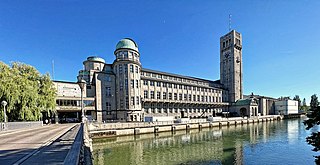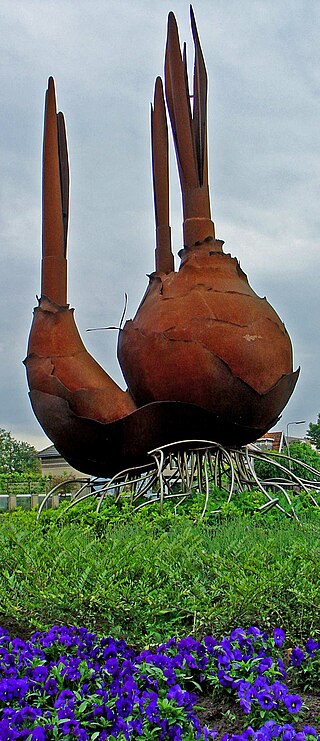
The Bureau International des Expositions is an intergovernmental organization created to supervise international exhibitions falling under the jurisdiction of the Convention Relating to International Exhibitions.

The Deutsches Museum in Munich, Germany, is the world's largest museum of science and technology, with about 125,000 exhibited objects from 50 fields of science and technology. It receives about 1.5 million visitors per year.

The Baureihe 103 is a class of electric locomotives in Germany, originally operated by Deutsche Bundesbahn. For a long period, they were perceived as flagships of the DB rolling stock.

Darmstädter Ferienkurse is a regular summer event of contemporary classical music in Darmstadt, Hesse, Germany. It was founded in 1946, under the name "Ferienkurse für Internationale Neue Musik Darmstadt", as a gathering with lectures and concerts over several summer weeks. Composers, performers, theorists and philosophers of contemporary music met first annually until 1970, and then biennially. The event was organised by the Kranichsteiner Musikinstitut, which was renamed Internationales Musikinstitut Darmstadt (IMD). It is regarded as a leading international forum of contemporary and experimental music with a focus on composition. The festival awards the Kranichsteiner Musikpreis for performers and young composers.

A garden festival is a festival and exposition held to celebrate the arts of gardening, garden design, landscaping and landscape architecture. There are local garden festivals, regional garden festivals, national garden festivals and international garden festivals. The idea probably originated with Germany's Bundesgartenschau. The UK held five garden festivals in the period 1984–1992.

The Brussels International Exposition of 1935 was a world's fair held between 27 April and 6 November 1935 on the Heysel/Heizel Plateau in Brussels, Belgium.
The International Youth Library (IYL) in Munich is a library that specializes in the collection of children and youth literature from around the world in order to make them available to the public, focusing on the international community. This library is the largest of its kind worldwide, and has been operating since June 1983, in Blutenburg Castle in the Munich district Obermenzing, before this time the library was located in Schwabing.

Expo 2017 Astana was an International Exposition which took place from June 10 to September 10, 2017 in Astana, Kazakhstan. The expo's theme was "Future Energy", and aimed to create a global debate between countries, nongovernmental organizations, companies and the general public on the crucial question: "How do we ensure safe and sustainable access to energy for all while reducing CO2 emissions?"

The Ghent International Exposition of 1913 was a world's fair held in Ghent, Belgium, from 26 April to 3 November 1913.

The Brussels International Exposition of 1910 was a world's fair held in Brussels, Belgium, from 23 April to 1 November 1910. This was just thirteen years after Brussels' previous world's fair. It received 13 million visitors, covered 88 hectares and lost 100,000 Belgian francs.

The Second International Aeronautic Exhibition, (full name Second International Aeronautical Exhibition in the league Air Defence of Finland SILI) was held in Helsinki in 1938. It ran from 14 May to 22 May 1938.
The Exposition internationale de la technique de l'eau de 1939 was the third specialized exposition recognized by the Bureau International des Expositions. In 1936 Georges Truffaut proposed an exposition to celebrate the completion of the Albert Canal. The exposition's theme was water management and opened on 20 May 1939 by King Leopold III of Belgium. The canal itself was opened on 30 July 1939.

Floriade 1992 was an international garden exhibition held in Zoetermeer, Netherlands, recognized by the Bureau International des Expositions (BIE) and organized under the authority of the Dutch Ministry of Agriculture and Fisheries. The Floriade ran from April 9 to October 10, 1992, and was held on a converted pasture outside Zoetermeer near The Hague. The exhibition covered 168 acres and had participants from more than 20 countries. Thirteen foreign countries participated. The Floriade hosted 3.36 million visitors.

Japanische Internationale Schule München e.V. is a Japanese international school in Sendling, Munich, Germany. It serves both elementary and junior high school levels.

The Floralies Internationales de Montréal was the 8th international horticultural exposition recognized by the Bureau of International Expositions. It was held during the spring and summer of 1980, from May 17 to September 1. The Expo was split in two sequential exhibitions, starting with an indoor event in the former Montreal Olympic Velodrome and later on different gardens on Notre Dame Island, the site of the Expo 67. 17 countries were represented at the indoor exhibition and the Velodrome was converted to the Montreal Biodome afterwards. The indoor exhibition opened on May 17 and closed May 29. The gardens at the outdoor part opened on May 31. 12 countries showed their gardens to the public during the summer until September 1.
Highlights – Internationale Kunstmesse München is an exhibition of art and antiques in a wide range from ancient to modern. The art fair dates back to the "Deutsche Kunst und Antiquitätenmesse" initiated by Otto Bernheimer in 1956. The event, located in the Munich Haus der Kunst, is held annually in the fall and runs for 10 days. The current initiators of the exhibition are 19 art dealers who have established themselves at The European Fine Art Fair (TEFAF) in Maastricht, Netherlands, over the last two decades.
International Garden Expo 83 was a garden festival containing 170 exhibition contributors. The international horticultural exposition was recognised by the Bureau International des Expositions (BIE) and held from April 28 to October 9, 1983, at Westpark in Munich, Germany. Ralph Siegel wrote the Flower Serenade as official song of the exhibition; it was recorded by Hugo Strasser and his orchestra. The German Federal Post Office issued a special stamp with a stylized flower.
The International Gartenbauausstellung 73 was a garden festival held in Hamburg, Germany, which was recognized by the Bureau International des Expositions. The exposition was the 6th edition of the international horticultural exposition organised under the auspices of the Association of International Horticultural Producers (AIPH) and the second held at Planten un Blomen park in Hamburg. The exhibition took place on the same site where IGA 63 was held a decade earlier. There were some changes to the site location, such as the vaulting of the Marseillerstrasse so that visitors throughout the area without crossing could visit. Instead of a cable car, a park trail was constructed on the site to provide for visitors. The line had four stations and took 30 minutes to complete a lap.
The International Exhibition on Urbanism and Housing was a specialized exhibition recognised by the Bureau International des Expositions (BIE), which held in Paris, France, from 10 July to 15 August 1947. It focused on housing estate projects in the context of post-war reconstruction and attracted 14 participating countries including Mexico, Poland and South Africa.














